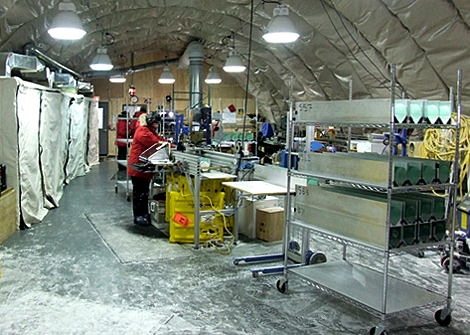|
Page 3/3 - Posted August 20, 2010
New methodologiesSchoenenmann, a tall, lean man with a fondness for rock climbing, is interested in developing a new methodology for measuring the stable isotope oxygen-17. The work will provide new information on the sea surface humidity during the Last Glacial Maximum (LGM), when the last glacial period peaked about 20,000 years ago. Previous research indicated conditions were dry, but other data suggest the humidity may have been higher, accompanied by more precipitation, according to Schoenenmann. He hopes the O17 record will shed more light on the issue. “It’s really an exciting new measurement,” he said. “The WAIS Divide record will be the first one to have an O17 record.” Thomas Bauska Like Schoenenmann, he has developed a new methodology to analyze stable isotopes in the gases trapped in the ice — in this case, carbon-12 and carbon-13 — working in the laboratory with WAIS Divide PI Ed Brook at Oregon State University The gas measurements are perhaps some of the most exciting because they will address a central question regarding the relationship between carbon dioxide and temperature. Current ice core records show that in the past temperature increased, followed several centuries later by an increase in carbon dioxide — but there is still a large uncertainty in the timing of this sequence. Most scientists believe past climate warming was caused by variations in the Earth’s orbit, called Milankovitch cycles, which changed how sunlight was distributed on the surface of the planet. But the orbital changes alone are probably not enough to end an ice age, just to initiate environmental changes that allow more carbon dioxide into the atmosphere to create the greenhouse effect. “Humans are now increasing the level of CO2 in the atmosphere to levels higher than at any time in the last 800,000 years,” Taylor explained. “The effect will be similar to what happened when changes in the Earth’s orbit caused the oceans to release CO2: No change for while, then lots of warming and changes in rainfall on a scale that humans have never experienced.” By studying ice cores, which record how this process worked in the past, scientists will be able to predict more accurately how human releases of CO2 will affect climate. Specifically, the analysis of the ancient ice by Bauska and others will identify the sources of CO2 and help figure out why it varies naturally. “You need the large amount of samples that WAIS Divide can give us to make these measurements,” Bauska noted. Ice timeResults from the work by young scientists like Schoenenmann, Koffman, Fudge, Bauska and the many PIs are still well down the road, according to Taylor. Only about 600 meters of ice has been processed previously, containing the most recent 2,000 years of climate history. 
Photo Credit: Chad Naughton
The core-handling room at WAIS Divide, which is kept at minus 25 centigrade.
“That’s the annoying thing with these ice cores. You drill them, and it can be like two years before the ice gets to the lab. It’s another year or two of measurements. And then another couple of years to figure out what it [means],” Taylor mused. The brittle ice being processed this summer was originally cored from the ice sheet during the brief 2008-09 field season. It had to spend a year on site before it could be moved to allow the ice to “relax” so it would not become brittle and get damaged during transport to the United States. The delay is partly due to the need for conducting the CPL and the different analyses back in the United States. That’s in contrast to projects like GISP-2, Greenland Ice Sheet Project 2 In Greenland, the scientists make many measurements in a snow trench carved out for that purpose. However, it’s too expensive to bring all of the equipment and people needed for such an operation to West Antarctica, where the field camp is reached by a ski-equipped military aircraft when the weather is good enough to fly. “Going to Greenland is like a vacation compared to a place like WAIS Divide, where it takes at least three weeks just to come and join us for lunch,” Taylor said. By the time the CPL crew reaches about 2,000 meters in mid-August, the climate record will reach back about 8,000 years. The first 40,000 years are expected to be thick enough for the annual layers to be counted before the ice flow makes the layers too thin to resolve. Taylor said he is hopeful that the drilling team will reach its final target depth of 3,330 meters during the 2010-11 season, bringing back another 1,400 meters of ice for next summer’s CPL. “We’re really looking forward to pushing that last piece of ice through the drill,” Taylor said. NSF-funded research in this story: Kendrick Taylor, Desert Research Institute, Award Nos. 0944191, 0440817, 0440819, 0944348, 0739780 and 0230396 |



For USAP Participants |
For The Public |
For Researchers and EducatorsContact UsNational Science FoundationOffice of Polar Programs Geosciences Directorate 2415 Eisenhower Avenue, Suite W7100 Alexandria, VA 22314 Sign up for the NSF Office of Polar Programs newsletter and events. Feedback Form |



